STUDYING THE SUN OVER UDAIPUR
Outline for proposed article about the Udaipur Solar Observatory, Udaipur,
India.
In Spring of1996 I was invited to attend the wedding of a friend and high
school teacher who lives near Udaipur, India. The invitation caught me at
a time when I was ready to take a break from Silicon Valley and visit someplace
that was truly exotic.
I booked a flight to New Delhi. After landing in the middle of the night,
I found a taxi driver who was willing to drive me to Udaipur. The ride through
the night was a wild experience, but I arrived safely in Udaipur in time
for the wedding. I discovered that Udaipur is an ancient city with a busy
city center, a maharaja's palace on a hill, and forts on the highest hills.
I was surprised to see observatory domes reflecting the hazy morning sun from
the middle of the lake in Udaipur.
4-24.jpg
Photo by Paul Copeland 
This winter Jan 2001 I returned to India with my brother Paul Copeland
to attend the Mahakumbhamela held every 12 years in Allahabad. After the
Mahakumbamela we went to Udaipur to visit my old friend Onkar to learn more
about the Udaipur Observatory.
I assumed that the observatory was an amateur site or at best used by
a local college for astronomy instruction. I contacted the head, Dr. Venkatakrishnan
by telephone and found that the name of the observatory is the Udaipur Solar
Observatory (USO). I was surprised to find that the USO is doing world class
solar studies.
We obtained a car and driver from the Indian Tourist Office and drove
to Udaipur. I experienced another wild ride dodging lorries, camel carts,
elephants, holy cows, and the occasional gang of monkeys.
The first morning Paul and I walked along the lake to get a better view
of the observatory. To our astonishment a flock of flamingoes flew in and
took up feeding in the lake next to the island holding the observatory.
4-31.jpg
Photo by Paul Copeland 
The next day we were warmly welcomed by Dr. Venkatakrishnan. He told us
he was happy to show us around and answer any questions.
Photo by Paul Copeland

Dr. Venkatakrishnan introduced us to his staff.
Photo by Paul Copeland

Back row, from left: Rakesh Jaroli, office clerk; B. Ravindra, research
scholar; Shankar Lal Daliwal, helper; Brajesh Kumar, scientist; Ramchandra,
carpenter; Raju Koshy, tradesman.
Middle row seated from left: Sanjay Gosain, scientist; P. Venkatakrishnan,
professor and head of USO; Arvind Bhatnagar, emeritus scientist, founder
and former head of USO; Ashok Ambastka, Associate professor; Sudhir K. Gupta,
technical assistant.
Bottom row from left: TBD.
On the Island
Dr. Venkatakrishnan lead us on a short hike to the edge of the lake. On
the island opposite to where we were standing a small rowboat was waiting
with one of his staff, who rowed rowed us across. We climbed up some stairs
and saw the domes of the observatory in a different light. What a peaceful,
cool island.
Photo by Paul Copeland

As we climbed up the stairs, Dr. Vendatakrishnan told us we are part of
a behavoiral experiment, but he couldn't tell us the nature of the experiment
until it was time to go. His eyes twinkled mysteriously, but then he went
on to the next subject -- the USO instruments.
Instruments - USO Telescopes
Full Disk Telescope
A 6-foot Razdow telescope, with a 15-cm aperture lens, takes full disk
H-alpha synoptic observations of solar activity. CCD cameras, monitors and
a digital image acquistion and processing system provide real time monitoring.
Photo, courtesy USO
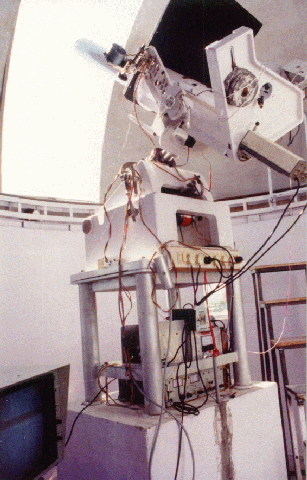
High Resolution Spar telescope
A 12-foot solar spar with 25-cm aperture telescope is being used for observing
small high resolution chromospheric structures with the help of a narrow
passband Halle-birefringent filtered contered at 6563A H-alpha spectral line.
The light beam can be diverted to other instruments for simultaneous study
of different aspects of solar event.
Photo Courtesy USO
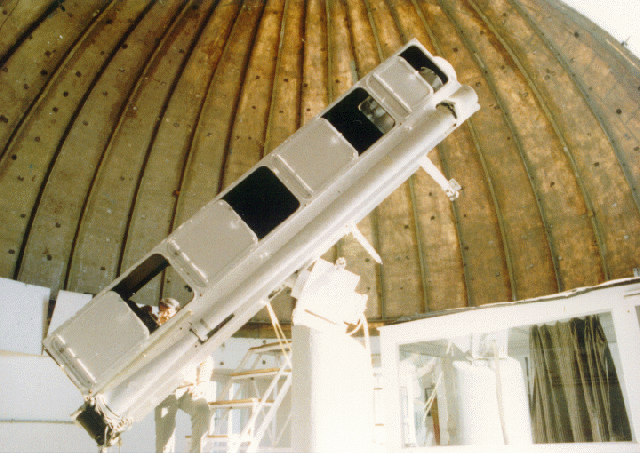
Coudé Telescope
A 15-cm Zeiss Coude telescope is being operated for spectral study of
solar prominences, flares, and active regions, and for testing optics and
filters. The advantage of this telescope is that it can track the sun and
feed the solar beam to heavy back end equipment placed on a stationary platform.
tel2.gif has the following structure:
Courtesy USO
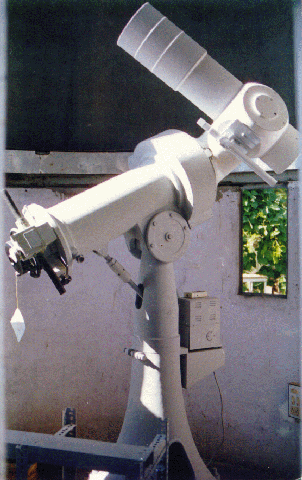
Photo by Paul Copeland

9-20.jpg
Photo by Paul Copeland

Dr. Venkatakrishnan and assistant watch the whole sun's disk as captured
by the Coudé telescope on a high-resolution monitor.
9-17.jpg
Photo by Paul Copeland 
GONG Telescope
A milestone was added to USO's history in October 1995, when it appeared
on the world map as an important link in an international project, GONG -
Global Oscillations Network Group. The USO is one of six sites around the
world. USO was selected owing to its excellent observing and sky conditions.
The other five sites selected under GONG are located at the Canary islands
(Spain), CTIO (Chile), Big Bear (USA), Hawaii (USA), and Learmonth (Australia),
for a near continuous 24 hour solar coverage with the aim of probing the
solar interior. The sophisticated, 1.5 million dollar, state-of-the-art instrument
monitors the Sun automatically, and takes digital velocity images of the
sun every minute. The USO data is then combined with the data obtained from
other five sites at the central facility located at National Solar Observatory,
Tucson, USA. The GONG project promises to unravel several fundamental problems
of solar interior and general astrophysics.
The GONG instrument is not located on the island, but up a hill half a
kilometer from the USO headquarters building.
The GONG instrument is based on a Michelson interferometer called a Fourier
Tachometer and is supported by the National Science Foundation through the
National Solar Observatory which is operated under a cooperative agreement
between the Association of Universities for Research in Astronomy and the
NSF.
Sudhir Gupta the responsible for maintaining the instrument. He took us
there and showed us the instrument.
9-1.jpg
Photo by Paul Copeland 
Sudhir points out the mirror that follows the sun's position and reflects
its image into fixed telescope tube.
The instrument sends data automatically to its home base via a satellite
dish. Below, Sudhir sits at his workstation where he monitors the status
of GONG, changes the data tapes, and backs up all data.
9-7.jpg
Photo by Paul Copeland 
History of the USO
Professor Arvind Bhatnagar (now Emeritus Scientist) built this facility
starting in 1975. Before that he was supervisor of the Big Bear Solar Observatory
in the San Bernadino Mountains of California, USA (http://www.bbso.njit.edu/).
He went there on a Carnegie Fellowship. Two scientists visited him from India
in 1971 and asked why there was no such facility in India.
Dr. Bhatnagar agreed and wrote a proposal to PRL to build a "Big Bear
east." He argued as follows:
-
Latitude: India is at nearly the opposite latitude of Big Bear Solar Observatory,
and consequently would allow almost 24 hour observation of the sun.
-
Climate: Rajasthan and the San Bernadino Mountains have similar dry climates
with few cloudy days.
The proposal was funded and by 1975 a modest solar observatory was started.
The instruments were donated by friends, notably Dr. Ron Giovenelli, an Australian
solar astronomer. The first observations were made in 1976.
Solar Studies at the USO
-
High resolution images of the sun, using various filters such a Hydrogen-alpha.
-
The relation between coronal holes and soft X-ray emission.
-
Sunspots, flares, filaments, and mass ejections
-
The magnetic properties of solar plasma.
-
Solar seismology
Dr Venkatakrishnan explained that they put the observatory in the middle
of the lake to cut down on heat radiating through the atmosphere. The water
absorbs most of the sun's energy and reradiates very little.
"However," he went on, "we do experrence some radiative distortion and
we can compensate for much of the distortion with our image processing software.
A more complete solution to overcome the distortion would be to build a Multi
Aperture Solar Telescope (MAST). We currently have a proposal in to our
parent laboratory, the Indian Government Physical Research Laboratory."
Examples of Studies
[Taken from lecture materials provided by professor Ashok Ambastha, USO.]
Solar Disk Study
Photo courtesy USO
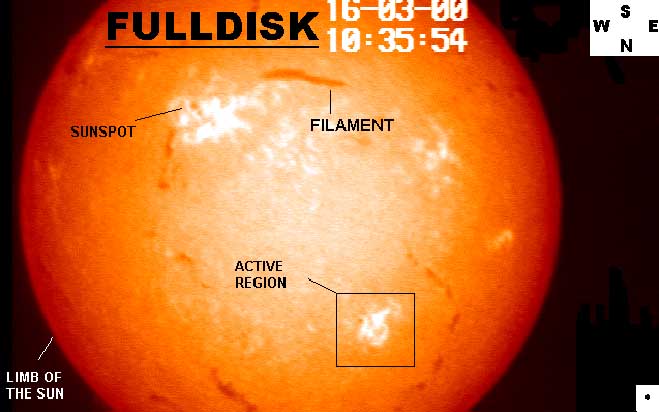
High Resolution Sunspot Study
Courtesy USO
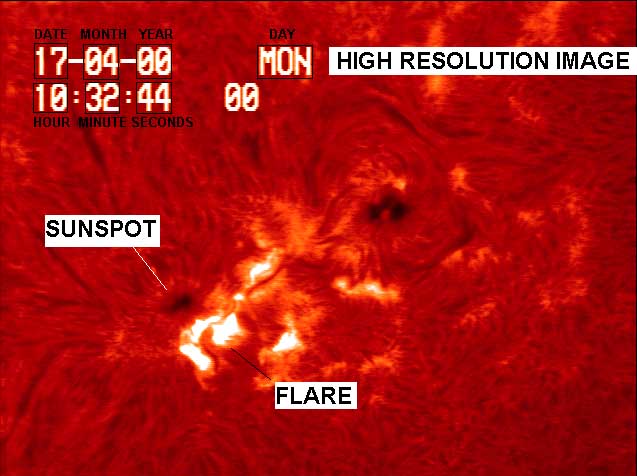
Mass Ejection
The following image shows an example of Mass Ejection study from February
1999.
courtesy USO.
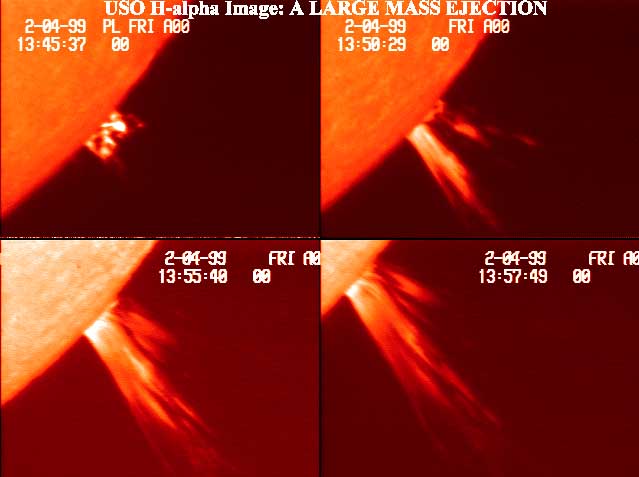
Study of Magnetic Properties of Plasma Loop
The following image shows part of a sequence recorded of the rise and
escape of a loop prominence.
Courtesy of USO.
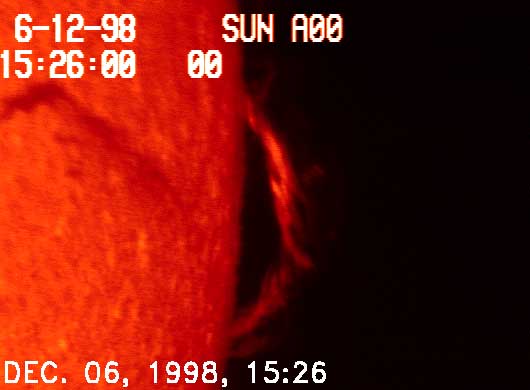
X-ray Detection Study Over the Period of a Day
Courtesy USO.

Departure
As we left the observatory the sun was setting. I caught a glimpse of
the red sun sitting like an incandescent egg in a palm tree next to the
dome. It seemed like we had only been there a few minutes, and yet the whole
day had passed away. I remarked about this to Dr. Venkatakrishnan. He broke
out in a big smile and thanked us for providing more data for his behavioral
experiment.
"What was that?" I asked.
"Most people who spend time on this little island lose touch with the
passing of time, just as you did.
4-16.jpg

Related Websites
Udaipur Solar Observatory, Home Page
http://www.uso.ernet.in/
GONG Project
http://www.gong.noao.edu/
Big Bear Solar Observatory
http://www.bbso.njit.edu/



